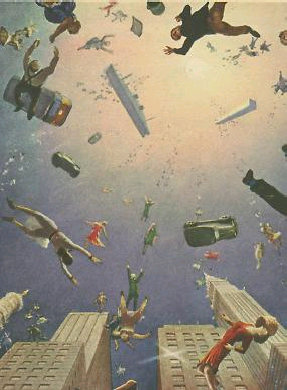Mood:
Now Playing: Mark Levin

What with modern Hollywood hell-bent upon crashing and burning via a stream of thoroughly insipid films, I’ve been attempting to make the most of my NetFlix membership by mining the many forgotten classics of a better time. One film that I recently rented was the George Pal classic, When Worlds Collide. Now, while I have always been a fan of George Pal – I consider his version of War of the Worlds to be a masterpiece not just in terms of interpreting the original H. G. Wells story, but in terms of the totality of cinematic sci-fi as well – I confess that I did not enjoy this film. My complaint is ultimately a familiar one: it suffers from a complete lack of realism.
In case you have never seen it, When Worlds Collide is about the destruction of Earth via a cosmic collision. Specifically, the star Bellus, along with its accompanying planet Zyra, is headed our way and destined to smash into Earth, extinguishing all life on the planet. Ultimately, the movie revolves around an international effort of scientists and businessmen who build a series of rocket ships to save a select group of people and repopulate them on the passing planet Zyra (this story was somewhat revisited with greater realism in Michael Flynn’s Firestar series). Now, in and of itself, the premise of this particular disaster is not at all implausible. The Milky Way galaxy is a violent place and such collisions take place all the time. No, what ticked me off was not the event, but the portrayal of the collision.
To begin with, the close passing of the planet Zyra is depicted as little more than a rough Californian day with some moderate earthquakes, flooding, and, inexplicably, a lot of wind. That’s about it! What a shame! For the truth of the matter is that such an event would wreak solar system chaos. Our solar system is a remarkably delicate clockwork mechanism. With the introduction of a major planetary body - not to mention a star! – that gravitational balance would be terribly upset. It is entirely conceivable (indeed, probable) that the orbits of the inner planets would be disturbed, perhaps even with the result of one or more being ejected from the inner solar system. And, just as likely, the gravitational perturbment caused by Zyra would shake loose the asteroids slumbering quietly in orbit between Mars and Jupiter, causing a deadly shower to fall upon the inner planets. And what about our moon? With the close passage of this new planet, the moon would most definitely be affected, perhaps to the extent of being stripped from Earth and either cast out of the solar system or, much worse, flung into Mars or Venus (talk about fireworks! ![]() ). It is even conceivable that it would be captured by its new master, Zyra (for a terrifying look at a lunar calamity, check out Jack McDevitt’s excellent Moonfall). Alas, none of this epic chaos was even suggested in the movie, let alone depicted. We weren’t even treated to a scene that showed the new planet glowing like a malevolent eye our skies – as it most surely would do as it closed in upon us. What a missed opportunity.
). It is even conceivable that it would be captured by its new master, Zyra (for a terrifying look at a lunar calamity, check out Jack McDevitt’s excellent Moonfall). Alas, none of this epic chaos was even suggested in the movie, let alone depicted. We weren’t even treated to a scene that showed the new planet glowing like a malevolent eye our skies – as it most surely would do as it closed in upon us. What a missed opportunity.
Now, if the portrayal of Zyra was disappointing, the depiction of a second star added to dear Sol is downright silly. While the movie provides absolutely no information on the nature or size of Bellus, its uneventful arrival is ridiculous. In fact, there are no perceptible effects until Bellus actually impacts the Earth! Give me a break, we’re talking about a massive fusion engine in the sky here! As Thomas J. Sherrill mentions in his Sky & Telescope article entitled Envisioning the End of the World, even the distant passage of a cool Brown Dwarf would likely result in a “death by freezing scenario” as Earth’s ecliptic orbit becomes distorted and results in rapidly falling temperatures (recall the classic Twilight Zone’s episode, Midnight Sun). That is the best case scenario, mind you. For if a larger or denser star approached our solar system, the surface of the Earth could be literally vacuumed clean by the star’s gravitational field – that is, shortly before the Earth was pulled apart by gravitational tidal forces. And, needless to say, if we had a hot, energetic star intruding in our backyard, the mammoth increase in radiation would probably bake us long before impact (which would be like a flame "impacting" a moth).
Yes, yes, I know…the special effects needed to depict such horrific events did not exist in 1951. However, I don’t entirely buy this excuse as George Pal worked wonders with what he had in his War of the Worlds. I suppose When Worlds Collide is what it is. However, I do hope that when the remake of this film hits the big screen, the new version will be both more scientifically literate as well as containing more eye-popping fun. I am confident in the latter, but as for the former....![]()

